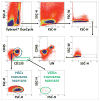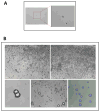A Novel View of the Adult Stem Cell Compartment From the Perspective of a Quiescent Population of Very Small Embryonic-Like Stem Cells
- PMID: 28057792
- PMCID: PMC5221475
- DOI: 10.1161/CIRCRESAHA.116.309362
A Novel View of the Adult Stem Cell Compartment From the Perspective of a Quiescent Population of Very Small Embryonic-Like Stem Cells
Abstract
Evidence has accumulated that adult hematopoietic tissues and other organs contain a population of dormant stem cells (SCs) that are more primitive than other, already restricted, monopotent tissue-committed SCs (TCSCs). These observations raise several questions, such as the developmental origin of these cells, their true pluripotent or multipotent nature, which surface markers they express, how they can be efficiently isolated from adult tissues, and what role they play in the adult organism. The phenotype of these cells and expression of some genes characteristic of embryonic SCs, epiblast SCs, and primordial germ cells suggests their early-embryonic deposition in developing tissues as precursors of adult SCs. In this review, we will critically discuss all these questions and the concept that small dormant SCs related to migratory primordial germ cells, described as very small embryonic-like SCs, are deposited during embryogenesis in bone marrow and other organs as a backup population for adult tissue-committed SCs and are involved in several processes related to tissue or organ rejuvenation, aging, and cancerogenesis. The most recent results on successful ex vivo expansion of human very small embryonic-like SC in chemically defined media free from feeder-layer cells open up new and exciting possibilities for their application in regenerative medicine.
Keywords: adult stem cells; germ layers; hematopoietic stem cells; parental imprinting; ras-GRF1; stem cells; very small embryonic like stem cells.
© 2017 American Heart Association, Inc.
Conflict of interest statement
– None to report
Figures


References
-
- Kucia M, Reca R, Campbell FR, Zuba-Surma E, Majka M, Ratajczak J, Ratajczak MZ. A population of very small embryonic-like (vsel) cxcr4(+)ssea-1(+)oct-4+ stem cells identified in adult bone marrow. Leukemia. 2006;20:857–869. - PubMed
-
- Ratajczak MZ, Machalinski B, Wojakowski W, Ratajczak J, Kucia M. A hypothesis for an embryonic origin of pluripotent oct-4(+) stem cells in adult bone marrow and other tissues. Leukemia. 2007;21:860–867. - PubMed
-
- Beltrami AP, Cesselli D, Bergamin N, Marcon P, Rigo S, Puppato E, D’Aurizio F, Verardo R, Piazza S, Pignatelli A, Poz A, Baccarani U, Damiani D, Fanin R, Mariuzzi L, Finato N, Masolini P, Burelli S, Belluzzi O, Schneider C, Beltrami CA. Multipotent cells can be generated in vitro from several adult human organs (heart, liver, and bone marrow) Blood. 2007;110:3438–3446. - PubMed
-
- D’Ippolito G, Diabira S, Howard GA, Menei P, Roos BA, Schiller PC. Marrow-isolated adult multilineage inducible (miami) cells, a unique population of postnatal young and old human cells with extensive expansion and differentiation potential. Journal of Cell Science. 2004;117:2971–2981. - PubMed
-
- Kogler G, Sensken S, Airey JA, Trapp T, Muschen M, Feldhahn N, Liedtke S, Sorg RV, Fischer J, Rosenbaum C, Greschat S, Knipper A, Bender J, Degistirici O, Gao J, Caplan AI, Colletti EJ, Almeida-Porada G, Muller HW, Zanjani E, Wernet P. A new human somatic stem cell from placental cord blood with intrinsic pluripotent differentiation potential. The Journal of Experimental Medicine. 2004;200:123–135. - PMC - PubMed
Publication types
MeSH terms
Grants and funding
LinkOut - more resources
Full Text Sources
Other Literature Sources

